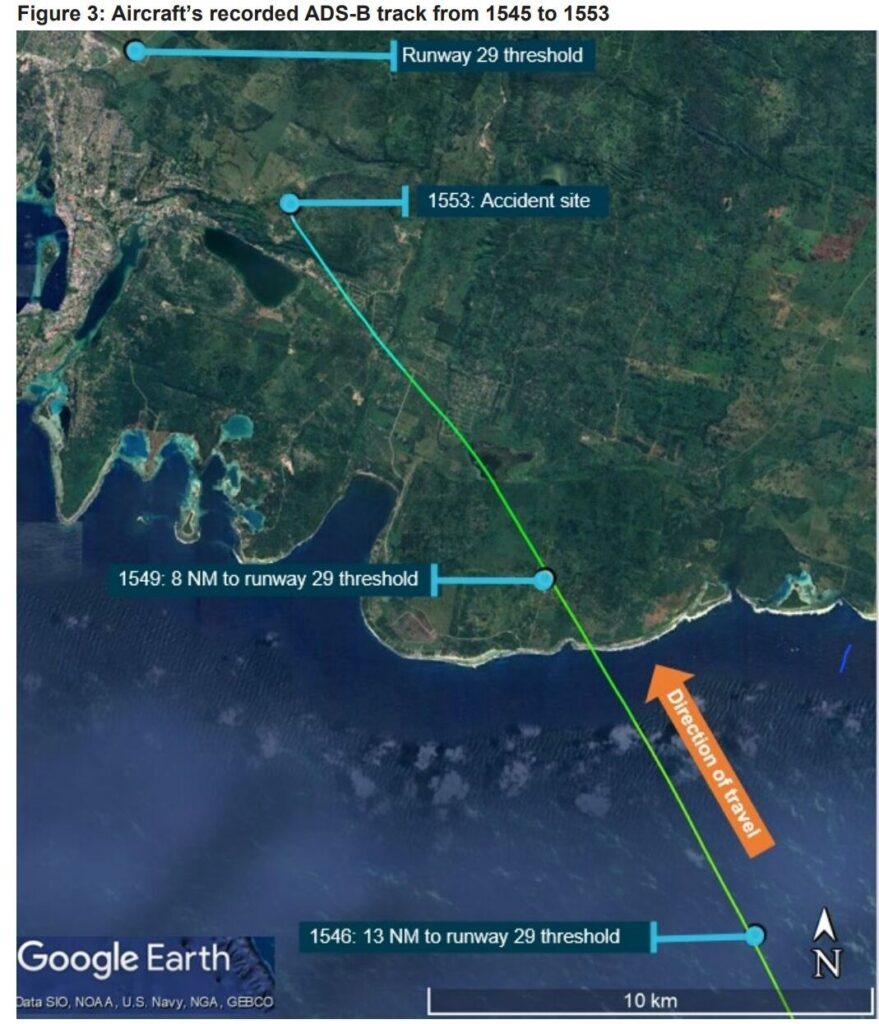Fuel Blunder Behind Air Taxi Crash
September 21, 2024 4:55 am | Posted in Business News | Share now TwitterFacebook
By Doddy Morris.

The Preliminary Report on the crash of the Air Taxi Britten-Norman Islander BN2A-20, YJ-AT2, on 15 July 2024, revealed that the cause of the accident was fuel starvation, leading to engine failure.
In response to the report, Simon Turner, Chief Executive Officer (CEO) of Air Taxi Vanuatu, stated that the normal fuel burn during cruise should be 55-60 litres per hour per engine.
“The pilot was running the engines at full mixture rich, contrary to Standard Operating Procedures and common sense, meaning he was burning about 30% more fuel than normal with no advantage in terms of speed. In fact, the aircraft may have been flying slower due to the excessive fuel-to-air ratio,” the Air Taxi CEO stated.
“The pilot did not plan for this additional fuel burn. His endurance at this higher rate was 3 hours with full main tanks, while normal operations allow for 4 hours. The flight time from Vila to Aneityum and back is 3 hours. If he had been operating the aircraft according to Air Taxi’s Standard Operating Procedures, he would have landed in Vila with one hour of fuel remaining. As it happened, he ran out of fuel after 3 hours of flying.”
Mr. Turner further noted that, as the operator, he accepts ultimate responsibility for this accident, but it is important to clarify that the pilot operated well outside Air Taxi’s Standard Operating Procedures and made numerous errors that resulted in the aircraft running out of fuel.
“We hired this pilot because he had over 10,000 hours of flying experience. The manner in which he ran the aircraft dry of fuel on that flight was beyond comprehension,” he said.
The Preliminary Report stated that the aircraft departed Aneityum at 14:12pm. The aircraft climbed for about 30 minutes to just above 10,000 ft as it tracked over the southern shore of Tanna. However, due to strong headwinds at that altitude, about 7 minutes after reaching cruise, the pilot chose to descend and maintain an altitude of about 7,500 ft.
“The aircraft passed over the west coast of Erromango between 15:09pm and 15:11pm. The pilot reported that after passing Erromango, they identified less fuel remaining than expected based on the quantity indicated on the main tank fuel gauges,” the Preliminary Report stated.
“Additionally, as the left main tank fuel gauge indicated slightly more fuel than the right main tank gauge, the pilot reported twice briefly cross-feeding fuel from the left main tank to the right engine until the main tank quantity indications matched.
“The pilot reported that at about 15:25pm, when approximately 50 NM from Port Vila, the fuel quantity gauges indicated about 10 US gallons (38 litres) remaining in each main tank, when they expected to have about 30 US gallons (114 litres) in each tank. The pilot also reported that at that time, the digital Fuel Scan instrument displayed a fuel flow of about 80 litres/hour on the left engine and 87 litres/hour on the right engine. As the aircraft was past halfway to Port Vila from the last available fuel at Tanna, the pilot decided to continue the flight.”
The report noted that at 15:41pm, about 23 NM from Port Vila, the pilot began a descent and about 4 minutes later contacted Vila Tower air traffic control and advised they were approaching the south coast of Efate at 5,000 ft and 13 NM from runway 29, reporting ‘engine problems’ and requiring assistance.
“During that radio transmission, a noise consistent with engine surging was audible. In response, the controller alerted the Aviation Rescue and Fire Fighting Services to stand by. The pilot reported that the right engine surged, ran roughly, and then stopped producing power,” the report further stated.
“At about 15:48pm, the pilot reported that shortly afterwards the left engine surged and then stopped. The pilot stated that following the engines ceasing to produce power, their initial actions were to push the respective mixture, pitch, and power levers to the full forward position, but they did not feather the propellers or attempt to transfer fuel from the auxiliary tank.”
The Civil Aviation Authority of Vanuatu (CAAV) clarified that the Preliminary Report was issued in accordance with international aviation regulations, which mandate investigations and public reporting following accidents. While the report outlines the root causes, CAAV officials emphasised that it is not intended to assign blame.
CAAV representatives stated they are working closely with Air Taxi to address the identified issues. “We are reviewing each root cause with Air Taxi to ensure their systems are corrected under CAAV rules. Once these issues are resolved, we will certify their compliance and publish the report with corrective actions to restore public confidence,” a CAAV spokesperson said.
The ongoing investigation and corrective actions will determine when Air Taxi will be cleared to resume operations.









